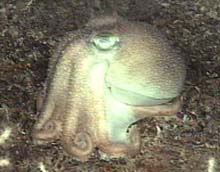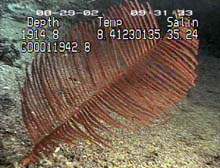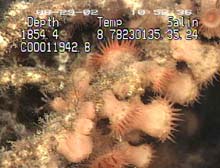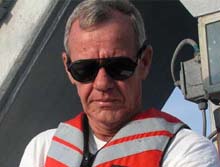Deep Coral Reefs May be More Extensive Than Their Shallow Water Counterparts
August 29, 2002
Paula Keener-Chavis
National Education Coordinator
NOAA Office of Ocean Exploration
![]() Watch a video of a deep sea coral bioluminescing as it is agitated by the manipulator arm of the Johnson-Sea-Link II submersible (mp4, 1.7 MB)
Watch a video of a deep sea coral bioluminescing as it is agitated by the manipulator arm of the Johnson-Sea-Link II submersible (mp4, 1.7 MB)
“I seem to have been only like a boy playing on the seashore, and diverting myself now and then finding another pebble or a prettier shell than ordinary, whilst the great ocean of truth lay all undiscovered before me.” --Isaac Newton
A front moved through yesterday with frequent thunderstorms, making sea conditions too rough to safely deploy and retrieve the submersible. Despite the dreary, almost early-autumn-like weather, work was underway in the lab as samples continued to be identified and processed. …but at a somewhat slower pace and to the rhythm of Eric Clapton, the Beatles, and a little opera now and then. It seems as if most welcomed a change in the routine. It brought a small reprieve and a chance to recover, however brief, some from the constant energy that one unknowingly expends to remain upright during the continuous - and very unpredictable- motion of the ship. Even though fathometer readings taken early in the morning showed what appeared to be a nice overhang with a 300-foot drop, exploration at this site will have to wait. The Seward Johnson is headed to Region 4 to conduct dives just south of the target site, which remains under entry restrictions due to hazardous Naval exercises in the area.
Region 4, approximately 90 miles off the coast of Jacksonville, Florida, has been the target of primarily geological studies in the past. C.K. Paull (2000), a geologist at the Monterey Bay Aquarium Research Institute, reported spectacular pinnacles and growth in this area in water as deep as 2,000 feet. No coordinates are available for the locations of these pinnacles, so using launch coordinates from the Johnson-Sea-Link, we've been able to determine very general positions for the structures. John Reed’s early morning fathometer transects discovered a large Lophelia pinnacle, or lithoherm, 2.6 miles in length along the north/south axis, with about 515 feet of relief, and seven individual peaks on top. An east-west transect across the structure revealed that it is approximately 1 mile wide. The slope of the structure is steep, as the depth dropped 315 feet across a horizontal distance of 1,300 feet. The orientation of this pinnacle is primarily parallel to the flow of the Gulf Stream. What we have seen thus far at other sites is that the structures have been oriented perpendicular to the current flow.
Although geologists investigated this area some time ago, there is no mention what lives here other than ‘coral.’ Paull estimated the living coral here to be about 700 years old, based on 14C (carbon-14) dating, and estimated the dead coral rubble to be 20,000 years old. Dives in 1990 and 1992 by the U.S. Navy’s NR1 and the Johnson-Sea-Link showed that there was, on the average, one pinnacle in this region every 3 km. If this distribution is similar throughout the region, then Paull estimates that there could be as many as 40,000 lithoherms in this area. He further estimates that if each of these lithoherms is approximately 50 x 200 sq m, then these lithoherms cover an area over 400 square kilometers. This is significant and greatly exceeds the estimated area covered by shallow coral reefs off the coast of Florida. It is hugely significant when one considers the potential biodiversity index of the region.
Submersible dives allow us to see invertebrate growth that is more dense than at any of the previous sites. Beautiful crinoids, sponges, corals, octopi, squid, and crabs are abundant here. Tonight, we are in transit to another site further south. In 1982, the Cord, a remotely-operated vehicle (ROV) owned and operated by HBOI, viewed this site and recorded a 350 ft-high pinnacle before crashing into it and damaging the ROV. Tomorrow, we have another chance.
Paull, C.K., A. C. Neumann, B.A. am Ende, W. Ussler III, and N.M. Rodriguez. Lithoherms on the Florida-Hatteras Slope, Mar. Geol. 166 (2000) 83-101.
Interview with Wesley Knight
Chief Engineer, R/V Seward Johnson
What is your role on the Seward Johnson?I am responsible for fixing engines, hydraulics, plumbing, and general vessel repair. It if breaks and I can't fix it, we go home. Basic physics, chemistry, mechanics are all skills I use in my work.
How did you get interested in this work?
I was in aircraft maintenance in the Army and I went to work for Ed Link in 1966. He was a pioneer in aviation and diving engineering and design. I worked on the Sea Diver, which was his personal yacht, and it was the first boat at Harbor Branch before the facility actually became “Harbor Branch.” I also worked on his airplane, which was a Grumman Wigeon.
What do you like most about what you do?
I like the challenge of keeping things running and solving problems that give me a bad time.
What do you find most challenging about your work?
When I have something new or something that I am not familiar with that breaks, it can be challenging to find out what is wrong and fix it. I don’t run into that very often any more, but occasionally it does happen.
Sign up for the Ocean Explorer E-mail Update List.


















































